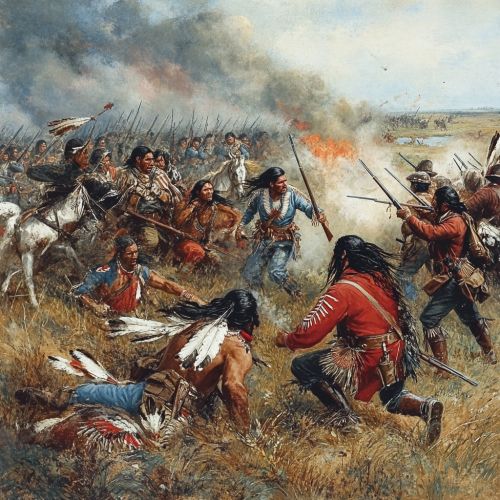Battle of Little Bighorn
Background
The Battle of the Little Bighorn, also known as Custer's Last Stand, was a significant engagement between the combined forces of the Lakota, Northern Cheyenne, and Arapaho tribes and the 7th Cavalry Regiment of the United States Army. The battle took place on June 25-26, 1876, near the Little Bighorn River in eastern Montana Territory. This conflict was part of the Great Sioux War of 1876, which was rooted in the United States' expansionist policies and the discovery of gold in the Black Hills, a region sacred to the Lakota people.
Prelude to the Battle
The origins of the conflict can be traced back to the Fort Laramie Treaty of 1868, which guaranteed the Lakota ownership of the Black Hills and hunting rights in the surrounding areas. However, the discovery of gold in the Black Hills in 1874 led to an influx of miners, and the U.S. government attempted to purchase the land. When the Lakota refused, tensions escalated.
In 1876, the U.S. government issued an ultimatum demanding that all Lakota and Cheyenne bands return to their reservations by January 31. Many Native American groups, led by prominent leaders such as Sitting Bull, Crazy Horse, and Gall, refused to comply, leading to military action.
The Combatants
Native American Forces
The Native American coalition was composed of Lakota Sioux, Northern Cheyenne, and Arapaho warriors. The exact number of combatants is debated, but estimates range from 1,500 to 2,500 warriors. The coalition was led by several key leaders, including Sitting Bull, who served as a spiritual leader and strategist, and Crazy Horse, who played a crucial role in the battlefield tactics.
United States Army
The 7th Cavalry Regiment, commanded by Lieutenant Colonel George Armstrong Custer, was part of a larger force under the overall command of Brigadier General Alfred Terry. Custer's regiment consisted of 12 companies, with approximately 700 men. The regiment was divided into three battalions, each led by Custer, Major Marcus Reno, and Captain Frederick Benteen.
The Battle
Initial Movements
On June 22, 1876, Custer's regiment left the main body of Terry's force to scout for the Native American encampment. On the morning of June 25, Custer's scouts reported a large village along the Little Bighorn River. Believing he had the element of surprise, Custer decided to attack immediately rather than wait for reinforcements.
Major Reno's Attack
Custer divided his regiment into three battalions. Major Reno was ordered to attack the southern end of the village, while Custer would lead a flanking maneuver to the north. Reno's battalion crossed the river and charged the village but was quickly overwhelmed by the sheer number of warriors. Reno ordered a retreat to a defensive position on the bluffs above the river, where his men were joined by Captain Benteen's battalion.


Custer's Last Stand
Custer's battalion continued its advance but soon encountered fierce resistance. The exact details of Custer's final moments remain unclear, but it is believed that his men were surrounded and annihilated by the combined Native American forces. The battle ended with the complete destruction of Custer's battalion, with Custer and over 200 of his men killed.
Aftermath
The Battle of the Little Bighorn was a significant victory for the Native American coalition, but it had far-reaching consequences. The defeat shocked the American public and led to a massive military response. Within a year, the U.S. Army had defeated the Lakota and Cheyenne, forcing them onto reservations.
The battle also marked the end of the traditional way of life for the Plains Indians. The U.S. government intensified its efforts to assimilate Native Americans, leading to the loss of their lands, culture, and autonomy.
Legacy
The Battle of the Little Bighorn has become a symbol of Native American resistance and a subject of extensive historical research and popular culture. The site of the battle is now preserved as the Little Bighorn Battlefield National Monument, which includes a memorial to the fallen soldiers and a monument honoring the Native American warriors.
